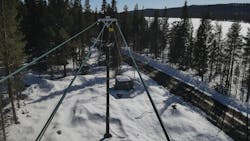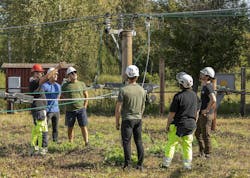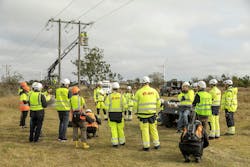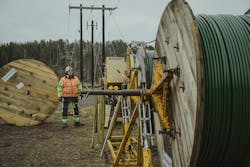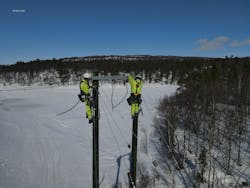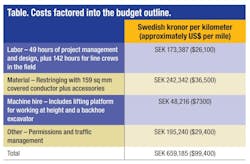Often referred to as tree wire in the U.S., covered conductor is used widely by E.ON in Sweden to ensure power continuity for its customers as well as the safety of its line crews. The technology was developed by Swedish cable company Amokabel in the 1990s in response to heavy winter storms causing trees to fall on lines. It has been improved over the years into the product it is today.
In many cases, covered conductor maintains supply even when a line has been downed. However, E.ON aims to minimize any risk to third parties, so its line crews respond as quickly as possible and prioritize the order in which fallen trees are removed.
This type of lightweight covered conductor system was developed for restringing existing poles. Rather than being bare wire, covered conductor has three protective layers made from modern lightweight polymers. This prevents electrical faults by stopping tree branches and foliage from coming into direct contact with live conductors. It has been deployed widely across E.ON’s 89,000-mile (143,000-km) network, particularly on 20-kV lines running through forested areas.
E.ON has upgraded its entire network with covered conductor, and no longer has any bare wire. Now, its current focus is on increasing grid capacity. Sweden’s electricity demand is forecasted to double by 2045 due to growth in electric vehicles and heat pumps, as well as the connection of distributed renewables and the electrification and decarbonization of industry. Today, E.ON uses conductors with cross-sectional areas of 62 sq mm, 99 sq mm, 159 sq mm and 241 sq mm (122.4 kcmil, 195.4 kcmil, 313.8 kcmil and 475.6 kcmil), depending on loads. The utility foresees upgrading covered conductor lines to higher cross-sections and higher voltages — for example, 52 kV — to cope with future demand and allow for spare capacity.
Cost Per Mile
This rolling program has given E.ON extensive experience with covered conductor. The utility has developed a budget outline to guide its investment. The outline uses a typical project cost for three phases of almost SEK 660,000 per km (approximately US$100,000 per mile).
This assumes a medium to challenging terrain in which a crew can cover 2 km (1.2 miles) per week. However, the timescales and costs can vary depending on the complexity of work, terrain and other site-specific factors. A project factor can be applied to account for more challenging conditions, while simpler projects away from roads are less costly because traffic management is not needed.
The budget accounts for 49 hours of engineering design and project management. This includes analysis of the line to evaluate the terrain and the procurement of materials, such as accessories, additional bracing and other site-specific needs. It also includes establishing a work plan, developing an environmental plan, and securing permissions and consulting with landowners, local authorities and road authorities.
Other costs include arranging permits for traffic closures and securing traffic barriers to protect line crews and members of the public.
When it comes to on-site labor, the budget includes 142 hours for E.ON’s line crews, which are typically three or four strong. Once on-site, they establish and prepare the site and put appropriate traffic management in place. The simplest approach is to have a guard in place during the line-pulling work. Then it is pulled without slack to maintain the line height in the intersection, or a catch line can be set up. In some projects, automated traffic lights might be used.
Electrical Work
Electrical work starts with switching to temporary lines. The team checks the status of poles and mounts additional bracing and anchoring, if necessary. Then the team dismantles and restrings the conductor onto the existing poles and adjusts or moves some poles if needed. The next step is to make connections and carry out switching to return the line to live status.
The most cost-effective approach is to assess the condition of existing poles before starting work and beginning the outage. This means any need for pole replacements, repairs or reinforcements is known in advance and can be planned for properly.
EON’s policy during line renovations is to replace all end poles and angles as a preventive measure. These are the hardest to replace during a storm and take the most time. The utility believes this standard requirement is worth the additional cost.
Another important factor to consider when replace existing poles is — when changing the conductor, for example, from aluminum conductor steel-reinforced (ACSR) 62 to covered conductor 62 — it becomes almost like pulling up ACSR 99 in terms of forces and weight. So, it is important for the poles to be dimensioned accurately. E.ON learned this the hard way when the covered conductor held up under fallen trees but the poles did not.
Budget Outline
The budget outline also allows for materials, machine hire and other costs. The baseline cost is calculated based on restringing three phases using conductor with a cross-section of 159 sq mm (314 kcmil), one of the larger cross-sections E.ON uses. Accessories also are included for jointing, bracing and anchoring as well as for rerigging or adjusting poles, if needed.
Straightforward System
When it comes to installation and handling of covered conductor, E.ON line workers have said it is similar to working with bare wire. In contrast, the alternative approach of undergrounding is similar to laying water mains or gas pipelines.
The type of covered conductor E.ON uses is based on a fully sealed system, which protects the line from water ingress. This requires the use of connectors that pierce through the insulation to make an electrical connection between conductors, while a mechanical clamp holds the connector in place and seals the joint against moisture. Each connection can be completed within seconds, as there is no need to strip insulation to make connections.
Lightning protection is another important factor for covered conductor because lightning arresters must be installed at key points (equipment poles, covered conductor to bare and underground transitions, and dead-ends).
Training Camp
To ensure crews have the skills and knowledge to tackle any overhead equipment they might face in the field, E.ON has its own training camp for technicians and contractors.
The camp includes every type of equipment a connection technician might encounter on E.ON’s real-world network, including poles, overhead lines, earth cables, cable cabinets, cable terminations and network stations. Every type and configuration of pole on the network is represented, with composite and wood poles, as well as all types of angles and end poles.
A low-height area provides an opportunity for practical demonstrations and hands-on learning without having to work at height. The camp also includes small substation demonstrators for crews to learn about transitioning between underground and overhead lines.
Feedback for Improvement
Located in the Swedish town of Alstermo, the training camp has helped to cut development time and improve product quality since covered conductor technology was first developed in the 1990s. It is hosted by Amokabel, which is an immediate neighbor and a manufacturer of covered conductor. The camp gives E.ON’s line crews an opportunity to provide feedback to the manufacturer on their experience working with conductors and accessories.
While covered conductors were developed to protect power continuity for customers during Nordic storms, it also can be used for other applications. For example, it is being used in Australia to cut wildfire risk as it is fully covered to prevent sparking, while being lightweight and resistant to abrasion and ultraviolet rays.
About the Author
Peter Ipsen
Peter Ipsen is a highly experienced Technical Expert at E.On Energidistribution, Sweden. He specializes in the design, implementation, and optimization of energy distribution networks and is a long-term member of various technical committees, including SEK, the Swedish national standardization body for electrical standards.
